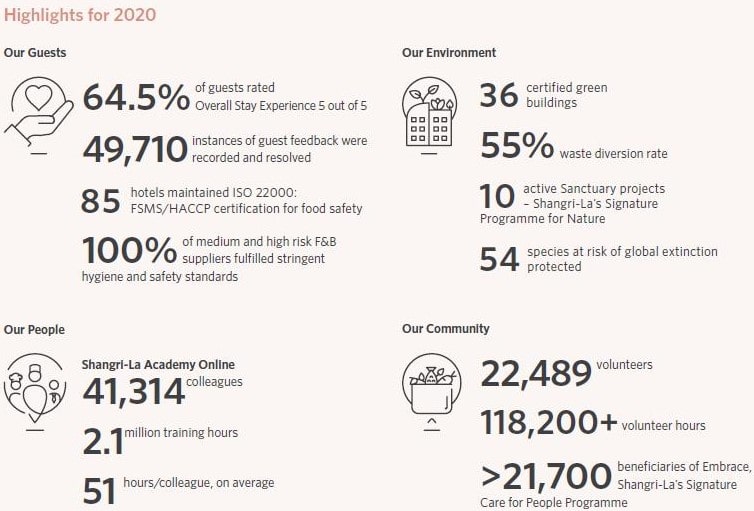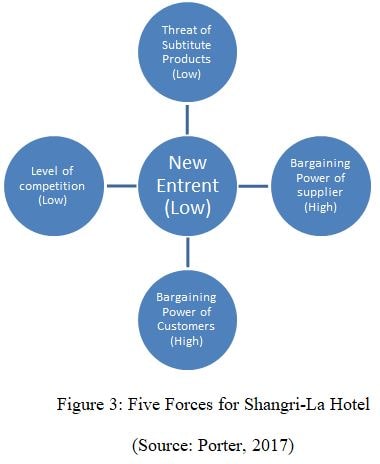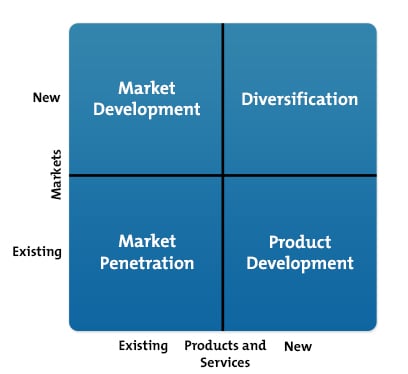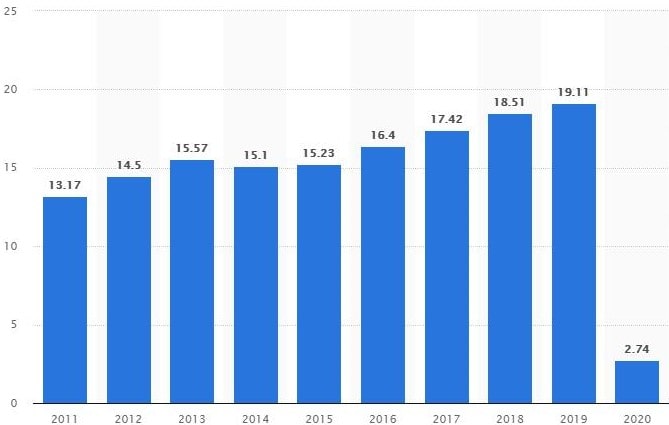Strategic Analysis of Shangri-La Hotel
Sep 24,21Strategic Analysis of Shangri-La Hotel
Question:
Discuss About The Strategic Analysis of Shangri-La Hotel
Answer:
Introduction
Shangri-La Hotel is a Hong-Kong based hotel that operates its business in different parts of the world such as Europe, Asia, Australia, and the Middle Eastern Zone. It is established as a luxury brand hotel that is mainly situated out-sides of a city in every target market to offer a peaceful and soothing environment to its target customers. This hotel company offers man-made natural views to its customers such as Waterfall, landscaped garden (Shangri-La International Hotel Management Ltd, 2021). This company established its global brand identity with the help of customer services and well-trained staff who satisfied customers.
Scope of Report
This report will analyze the strategies that are used by Shangri-La Hotel that help the company to perform in the market and gain competitive growth. For this, external and internal business environment analysis would be selected. This report will also conduct industry analysis with the help of competitors’ analysis to explore how the company is performing in the target market.
Challenges in Business
In performing business activities in the target market, Shangri-La Hotel is facing several challenges that affect the activities related to the business operation. As per the sustainability report of the hotel, Shangri-La Hotel improves its brand image in the market through attaining its CSR (corporate social responsibilities) (Shangri-La Group, 2020).

Figure 1: Performance of Shangri-La Hotel
(Source: Shangri-La Group, 2020)
But the focus on CSR is also affecting its operation’s sustainability. According to the report, the financial status of the company is supportive for the company to attain future objectives and goals. The main challenges that are faced by the firm are high carbon emission of products and services and consumption of a high amount of drinking water that restrict the company from attaining objectives and goals related to CSR. Therefore, the company is not able to perform its business at economies of scale with profitability.
External Analysis
This analysis can be done for a company with the help of few important analysis models that are below presented:
PESTEL Analysis
This analysis is conducted with the help of PESTEL analysis defined by Perera (2017) that describes the impacts of different external factors such as political, economic, social, technology factor legal, and environmental factor.
| Factors | Impacts |
| Political | The stable political environment supports from the government to tourism sectors of a country, strong relationship with most of the neighboring and other countries such as the US (Baruah, 2020). |
| Economic | Pandemic Covid-19 and global economic recession affect the economy of Singapore and reduce the flow of foreign tourists. Reduction in income inequality due to threat of an economic crisis in the world market (Baruah, 2020) |
| Social Factors | There was growth in international tourist since 2011 to 2019 that is a supportive factor for the hotel.
Figure 2: Number of international visitor arrivals in Singapore from 2011 to 2020 (Source: Statista, 2021)
Tourists have visited Singapore and there is a growth in sales of products. Demand for packaged tours in the country is also supportive of the hotel industry. |
| Technological | The use of online rental services facilitates customers to book rooms from their place. The flow of information through the IT system helps customers to access information related to services, rooms, and facilities from anywhere (Baruah, 2020). |
| Legal | Strict law for food safety management, standards for food hygiene(CoStar Realty Information Inc., 2021) |
| Environmental | Misuse of drinking water, the high carbon footprint of products and services |
Table 1: PESTLE Analysis
After analysis of the above factors, it can be stated that the CSR-oriented business policies of the Shangri-La Hotel are only effective to address the factors such as legal and environmental. The social factor will support the company to sustain in the market because while supportive tourism policy of the government is helpful to get regular customers in each season.
Five Forces Model
Porter’s Five Force models are a tool to explore the impacts of the external business environment on the performance of a company (Porter, 2017). For Shangri-La Hotel, below is the five forces analysis;

| External Forces | Intensity | Impacts on Company |
| Bargaining Power of Customers | High | It forces the company to introduce customer-oriented policies for their satisfaction. Otherwise, success cannot be possible |
| Bargaining Power of Supplier | High | For dealing with the suppliers, the company uses a long-term business contract to force suppliers to get their services at a reasonable cost. |
| Substitute | Low | Customers of Shangri-La Hotel are loyal to the services. |
| New Entrant | Low | The hotel industry needs huge capital investment, resources, planning, and workforce. Therefore, these factors develop barriers for the new entrant at a high level. |
| Level of Competition | Low | Shangri-La Hotel is a five-star hotel and in this context, there are only a few hotels therefore, the level of competition is not a very considerable factor. |
Table 2: Five Forces Analysis
Competitors’ Analysis
This analysis helps in exploring the competitive strength of a company in the selected target market. For the company in Singapore, many luxury hotel brands have an attractive brand image in the market. For example, Mandarin Oriental Singapore is famous for its legendary services to customers. It increases the visibility of business in the market through luxury services and rental rooms. This hotel selects a picturesque location for the establishment of its premises that attract the customers easily to consume its services (Mandarin Oriental Hotel Group Limited, 2021). On the other hand, this company is developing challenge to the Shangri-La Hotel in the term of variety of foods and mainly target female business travelers. Marriott Internal Inc. is another competitive hotel for the company as it also targets upper-class customers, business travelers, premium travelers, and leisure travelers. It has developed brand value by developing hotels at prime locations (Marriott International, Inc., 2021). It also served the customers through highly skilled staff. Career growth-oriented human resource policy of company helps it to retain employees for long-time. This company creates a challenge to Shangri-La Hotel in the upper-class customer segment. But it can be also stated that the new target customer groups such as middle-class customers in Singapore will facilitate the company to add new customers and gain long-term competitive growth and profits.
Internal Environmental Analysis
This Analysis is conducted with the help of the VRIO analysis model that is below defined:
VRIO analysis
Internal analysis of an organization is conducted effectively with the help of VRIO analysis that describes the factors which make a company’s operation more competitive in the market (Johnson et al., 2013). As per the sustainability report of the company, below is the VRIO analysis for the hotel:
| Resources | Valuable | Rare | Imitable | Non-Substitutable |
| Management of Human Resources | yes | Yes | No | Yes |
| Quality Services | Yes | Yes | No | Yes |
| Ambiance &Infrastructure | Yes | No | May be | Yes |
Core Competency
Shangri-La Hotel differentiates itself in the market with the help of high-quality services and quality products to customers. Such differentiation helps the company to establish a strong brand image in the Singapore market. The company achieved the satisfaction of customers by fostering service standards. It is also meeting the required level of the industry standards by providing a regular training program (Shangri-La Group, 2020). This process facilitates the employees to face the changes in customer needs and desires as well as to deal with the external market changes. Further satisfaction of employees is also the main objective of the company that facilitates it to deliver expected quality services to customers and meet their desire level. Shangri-La Hotel has also implemented a loyalty program “Golden Circle programme” (Shangri-La Group, 2020). It allows the company to increase business revenues by offering various benefits to customers. Social activities of the company such as vaccination support also facilitate it to make its social image and associate with the societies to get more customers every year.
Financial Analysis
The financial system of Shangri-La Hotel supports its growth strategy because it adjusts its financial policy as per market trends and performance. The financial report of the company reflects towards the positive performance but also reflects the decrease in revenues due to Covid-19. The consolidated revenue of company was USD 453.5 million for H1 2020(Hospitality Net, 2020). Therefore, the company needs to focus on qualitative actions in post-Covid scenario that would increase revenues and profits.
TOWS Matrix
| Threats
Entry of budget hotels in the industry; Scarcity of manpower, Increasing labor cost, terror attack, and the pandemic of Covid-19 |
Opportunity
Positive growth in the industry A rise in demand for budget hotels Quality services for tourists |
| Weaknesses
Non-considerable position outside of Asia-Pacific region; Limited Marketing strategies; Focus on the upper class and business traveler segment |
Strengths
Effective incorporation with the culture of the host country, quality-oriented brand image, quick delivery of services, emotional relationship with customers
|
Table 3: TOWS Matrix
As per this table, it can be stated that the new customer segment (middle-class customers) will provide an opportunity to the Shangri-La Hotel to deal with the existing weaknesses (see table) and retain revenues and profits for a long-time.
Recommendations
As per the above presented Table 3: TOWS Matrix, below are two recommendations that will help the company to sustain itself in market in the present scenario effectively:
Growth Strategy:

Figure 4: Ansoff Matrix
(Source: Fortin, 2017)
As per the help of the Ansoff matrix, Shangri-La Hotel should use the diversification strategy by developing new products range based on a reasonable price for targeting a new segment of the market such as the middle-class segment that is not targeting by the company (Fortin, 2017, .
Positioning Strategy
According to a report, the demand for budget hotel will increase in world market (Business Wire, Inc., 2021). Therefore, Shangri-La Hotel must focus on offering quality services to middle-class customers that help them to feel value for money. For this, the company must implement an economic price module for its services that will help in adding more customers and help the brand position itself differently in the market.
References
Baruah, P. (2020). Singapore PESTLE analysis. Retrieved from https://planningtank.com/market-research/singapore-pestle-analysis
Business Wire, Inc. (2021). Global Budget Hotels Market to 2023: Market data & insights on the global luxury hotels industry. Retrieved from https://www.businesswire.com/news/home/20200109005365/en/Global-Budget-Hotels-Market-to-2023-Market-data-insights-on-the-global-luxury-hotels-industry—ResearchAndMarkets.com
CoStar Realty Information Inc. (2021). Singapore Hotels to Increase Food Safety Upon Reopening. Retrieved from https://www.costar.com/article/8138231
Fortin, F. (2017). Ansoff Matrix Essntials. CreateSpace Independent Publishing Platform.
Hospitality Net (2020). Shangri-La Group Releases 2020 Full Year Results. Retrieved from https://www.hospitalitynet.org/news/4103652.html#:~:text=The%20weighted%20average%20occupancy%20of,year%20ended%2031%20December%202019
Johnson et al. (2013). Fundamentals of Strategy. Pearson UK. Shangri-La Group. (2020). Be part of our Shangri-La family. Retrieved from https://www.shangri-la.com/group/careers/
Mandarin Oriental Hotel Group Limited. (2021). Singapore. Retrieved from https://www.mandarinoriental.com/singapore/marina-bay/luxury-hotel
Marriott International, Inc. (2021). Asia Pacific. Retrieved from https://hotel-development.marriott.com/asia-pacific/
Perera, R. (2017). The PESTLE Analysis. Nerdynaut.
Porter, M. (2017). Competitive Strategy: Techniques for Analyzing Industries and Competitors. CreateSpace Independent Publishing Platform.
Shangri-La Group. (2020). Community and Social Impact. Retrieved from https://www.shangri-la.com/group/our-story/community-and-social-impact
Shangri-La Group. (2020). Pioneers of Asian Hospitality. Retrieved from https://www.shangri-la.com/group/our-story/
Shangri-La International Hotel Management Ltd. (2021). About Us. Retrieved from https://www.shangri-la.com/en/hongkong/islandshangrila/
Statista (2021). Number of international visitor arrivals in Singapore from 2011 to 2020. Retrieved from https://www.statista.com/statistics/977993/total-international-visitor-arrivals-singapore/






